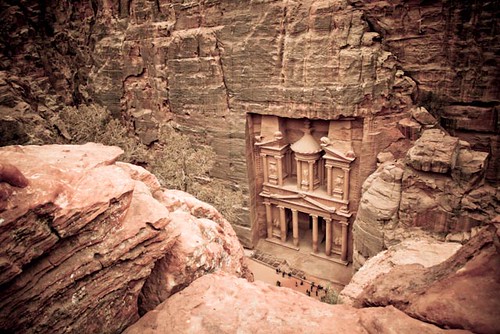Petra-fied
 I don’t think I can lift a finger tonight after spending nine hours hiking through the ruins of Petra, followed by a scrub and beat down in a nearby hammam. I may be sore, but the pain was worth it. Petra is truly amazing. They say that pictures don’t do it justice, and I agree. You just have to see it for yourself.
I don’t think I can lift a finger tonight after spending nine hours hiking through the ruins of Petra, followed by a scrub and beat down in a nearby hammam. I may be sore, but the pain was worth it. Petra is truly amazing. They say that pictures don’t do it justice, and I agree. You just have to see it for yourself.
I’ve been imagining Petra ever since Indiana Jones rode horses through the narrow gorge, and found himself in front of a towering Hellenistic monument carved from the sandstone rock. When I reach the point where the rock-hewn structure is visible through a small space in the narrow gorge, I am beaming. Emerging from the canyon, the Treasury towers overhead, nearly as tall as the cliff in which it’s carved.
Tomb raiders believed that an Egyptian pharaoh hid his treasure in the 12-foot-hight urn in the center of the structure and bullet holes in the urn show that someone tried in vain to “break open” the solid urn. The lure of Petra and its hidden secrets has been drawing people ever since. Known only to local Bedouin people for centuries, it became a Western obsession after an Indiana Jones-like Swiss explorer named Jean Louis Burckhardt rode into the rock city disguised as a Muslim holy man in 1812.
The place is now overrun with tourists in the high season, but thankfully we have the Treasury all to ourselves, thanks to an early start. The park opens at 6 a.m., but a vast majority visitors arrive around 10 a.m. when the tour buses roll into town.
There is a local bedouin man resting against his camel in front of the Treasury, waiting to give customers a ride. We pass on the opportunity and head further into the archaeological park, which stretches over a vast distance through mountains and canyons. Everywhere you turn, there are worn monuments and hand-carved cave tombs — the final resting place for great rulers. At one time, Petra was an important camel caravan stop on the Silk Road and had more than 30,000 inhabitants.
For the next nine hours, we explore what seemed like every inch of the area, sometimes climbing up the mountains to get dramatic views of the valley below. No matter how remote the place seemed, we encounter local bedouins selling jewelry, textiles and postcards. On top of a cliff near the Lion Monument, where water was channeled through the lions mouth, an ancient woman with tattoos on her face and two good teeth is offering a pack of postcards for one dinar. I buy them straight away if only to marvel in her ability to reach the high elevation on her own. She kissed me and patted my shoulder. Chris took a picture of her and I together, and I went to show her the image on the back of the camera. She then lifted her glasses to reveal her blind eye and said “God took it.”
Later, on the Al-Habis trail, we noticed a cave home, fully equipped with a satellite dish. I couldn’t help but stop for tea, which was advertised for one dinar on the fence, and chat with the owner.
“I am in that book of yours,” he says. Sure enough, on page 228 of Lonely Planet’s Jordan guidebook, Bdoul Mofleh is described as one of the last residents of Petra, following a government relocation to the nearby town of Wadi Musa in the 1980s. “I didn’t want to live in a box. It’s too crowded in the village.”
His only trouble in the world seems to be the goats that eat the beautiful flowers he’s planted in front of his house. There’s a flowering vine with fuschia-colored flowers growing up the side of the house, but all the other plants have been picked clean. “My geraniums are gone!”
While we sip tea and munch on a date-filled biscuit, he goes inside and brings out a box filled with ancient treasures he’s found throughout Petra. Tiny Nabatean oil lamps, miniature sculptures and Roman coins lay in front of us on the table. I can’t imagine trying to explain such items to U.S. Customs agents back home, so we pass on the opportunity to buy one of the treasures.
We thank him for the tea and now have the energy to climb steep steps to our final destination — the Monastery, a legendary rock monument , larger than the Treasury, that was used as a church during Byzantine times. We have to share the trail with donkeys hoisting tourists up the mountain. We spent the next 20 minutes dodging donkey dung and hoping we don’t get pushed off the edge of the cliff by the pack animals sporting names like “No Control.” If there’s any advice I can give future visitors, it would be to politely decline a donkey ride if you want to survive the trip.
When we arrive at the Monastery, someone is singing Christian songs from inside the large, cavernous opening at its base. The impromptu performance draws applause from bystanders. Just beyond the Monastery is a trail that leads to the edge of a cliff, where you can see Israel and the Palestine Territories. A sign at the look-out point says we have come to the “End of the World.”
By this point, we have reached our limit, too. We begin the long walk back to the exit of Petra in the late afternoon sun. There will be much more to see tomorrow.
INFO: Tickets to Petra cost 50 JOD ($75) for a single day entry and 55 JOD ($82) for two days and can be purchased at the visitor’s center across from the Movenpick Hotel. Other hotels within walking distance of Petra, include The Guest House and the dated Crowne Plaza Resort, which features the best views in town. Ask for a room overlooking the sandstone cliffs, dotted with caves.

Write a Reply or Comment